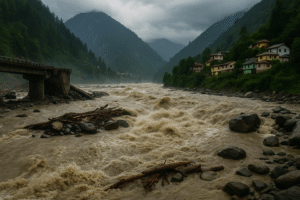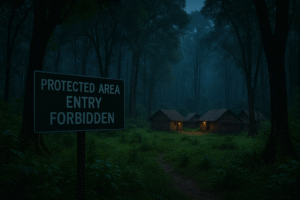Fun fact: The Himalayas are still rising by about 5 millimetres every year — meaning that Mount Everest, already the tallest peak in the world, is still getting taller. So, do mountains grow? The answer is both yes and no — and it’s a story as old as the Earth itself.
We tend to think of mountains as eternal, immovable, and unchanging. From the snow-capped peaks of the Himalayas to the rocky ridges of the Western Ghats, they seem like monuments carved into the planet forever. But in truth, mountains are alive in their own way — rising, eroding, shifting, and collapsing across millions of years. Mountains are not still statues; they are restless giants.
The Science of Growing Mountains
Mountains grow primarily because of plate tectonics — the movement of massive slabs of Earth’s crust. When two plates collide, the land between them buckles and pushes upward, creating ranges that scrape the skies.
Himalayas: Formed around 50 million years ago when the Indian Plate slammed into the Eurasian Plate, the Himalayas remain the most dramatic example. This collision is ongoing, which is why the mountains here are still rising even today.
Andes in South America: Formed as the Nazca Plate slips beneath the South American Plate, forcing the crust upward.
Alps in Europe: Shaped by the slow collision between the African and Eurasian Plates.
In essence, mountains are born in violent crashes, but they grow in slow motion. The same tectonic forces that shake cities with earthquakes also push mountains higher.
The Other Side of the Story: Erosion and Decay
If tectonic forces make mountains grow, erosion is what tears them down. Wind, water, ice, and even plant roots wear away rock grain by grain.
Take the Aravalli Range in India, one of the oldest mountain ranges in the world. Once as high as the Himalayas, today it has been worn down to rolling hills and ridges. The rocks whisper the story of their former grandeur, but time and erosion have humbled them.
Glaciers carve valleys, rivers slice through cliffs, landslides topple slopes — all contributing to the slow levelling of giants. So, while mountains rise, they are also constantly crumbling. Their fate is a balance between upward force and downward decay.
Case Studies and Anecdotes
The Himalayas: Still Alive, Still Growing
The Himalayas, stretching across five countries including India, Nepal, and Bhutan, are still rising as the Indian Plate continues its relentless push northward. This movement also triggers frequent earthquakes across the region, a reminder that these peaks are not static. Imagine that — while mountaineers are busy climbing Everest, the mountain itself is quietly climbing higher too.
The Western Ghats: Ancient Survivors
Unlike the Himalayas, the Western Ghats are not growing. They are ancient, shaped by volcanic activity millions of years ago. Over time, rains, rivers, and tropical weather have sculpted them into their present form. These ranges remind us that not all mountains are rising; some are simply enduring, wearing down into gentler slopes.
The Rockies and the Appalachians: A Tale of Two Ages
In the United States, the Rocky Mountains are relatively young, jagged, and tall, still uplifted by tectonic forces. By contrast, the Appalachian Mountains are ancient, once towering like the Rockies, but now worn down to modest hills. Their story mirrors that of the Aravallis in India.

Mountains in Motion: India’s Perspective
India gives us a front-row seat to the drama of mountain life.
The Himalayas are still rising but also experiencing massive erosion from monsoon rains and melting glaciers.
The Aravallis stand as ghostly remnants of Earth’s deep past, eroded over billions of years.
The Western Ghats highlight the power of weathering in tropical climates.
For Indian readers, these ranges are not abstract — they shape rivers, climate, agriculture, and even culture. Without the Himalayas, the monsoons would sweep across India differently. Without the Western Ghats, the Deccan Plateau would be barren. Mountains are not just geological structures; they are lifelines.
Do Mountains Ever Die?
Yes, in a way. When tectonic activity ceases, mountains stop growing. Over millions of years, erosion will grind them down until they are gone. What remains is often flat plains or gentle plateaus. The Aravallis and Appalachians are evidence of once-mighty mountains now in their twilight.
But even in “death,” mountains matter. The sediments eroded from them create fertile plains — the Ganga Basin, for instance, is fed by the eroded material of the Himalayas. So mountains give life long after their peaks crumble.
What Mountains Teach Us
Mountains embody patience. They rise so slowly we cannot see it, and they fall just as gradually. They teach us that even the mightiest structures are impermanent.
In an age where humans build skyscrapers and believe in permanence, mountains remind us: change is the only constant. They also remind us of resilience — even as they erode, they nourish rivers, shape ecosystems, and influence cultures.
Conclusion
So, do mountains grow? Yes, but they also shrink. They are caught in a cosmic tug-of-war between creation and destruction, rising by millimetres and eroding by millennia. Mountains are not eternal statues — they are restless giants, always in motion, even if too slow for us to notice.
The next time you stand before a peak, whether it’s the Himalayas or a hill near your hometown, remember- you are looking at a living monument, one that is still writing its story in stone.
Author’s Note
I wrote this because I believe mountains are among Earth’s greatest storytellers. They rise and fall like civilizations, teaching us about resilience, impermanence, and the beauty of slow change.
G.C., Ecosociosphere contributor.




